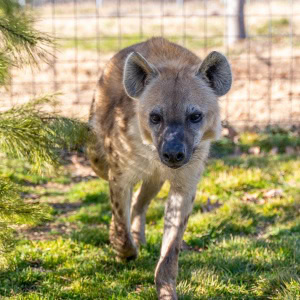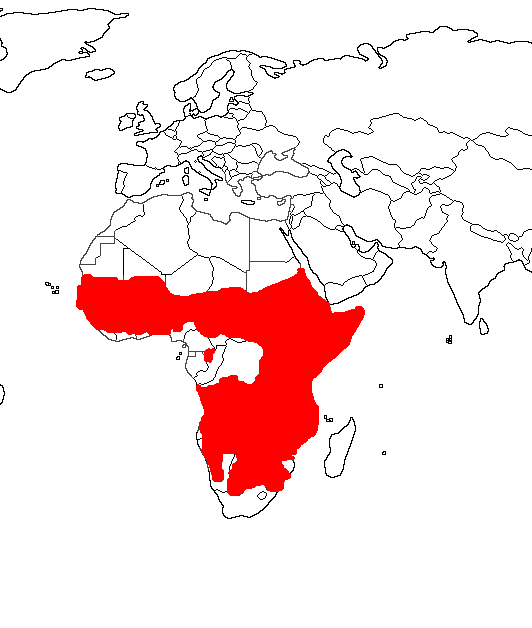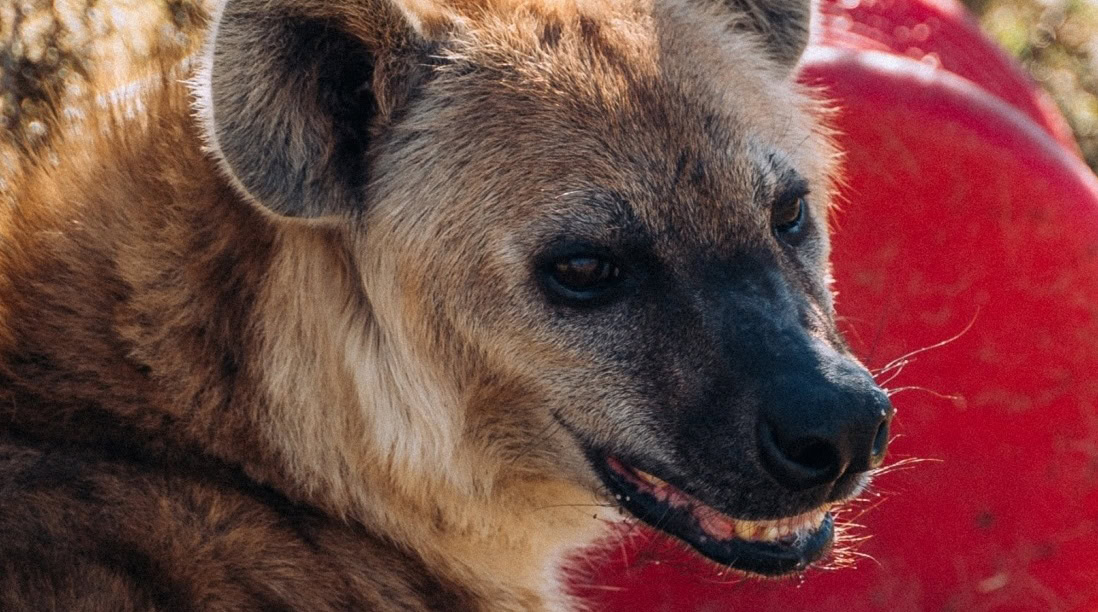
Taxonomy
Kingdom: Animalia
Phylum: Chordata
Class: Mammalia
Order: Carnivora
Family: Feliformia
Subfamily: Hyaenidae
Genus: Crocuta
Species: crocuta
Scientific Name: Crocuta crocuta
IUCN Red List Status: Least Concern
About
Habitat: Hyenas call Africa home, especially south of the Sahara Desert. They are able to survive in savannas and swamps, as well as semi-arid regions, grasslands, woodlands, forest edges, and even mountains up to 13,000 feet. They would rather rest in shallow pools or under bushes where they can find shade, than in a den.

Lifespan
In the Wild: Up to 25 years
In Captivity: Up to 40 years
Population
Less than 14,000 individuals
Other Species
Striped Hyena-Hyaena hyaena-found in northern Africa
Brown Hyena-Hyaena brunnea-found in the very tip of southern Africa
Aardwolf-Proteles cristata-found in the very tip of southern and the eastern edge of Africa
Territoriality: Hyenas are very territorial, but they group into clans of up to 80-100 related individuals. These animals have a matriarchal society. The females tend to be larger and with that comes the more assertive and aggressive behavior to males. The lowest ranking female cub can rank higher than the highest-ranking adult males. The lower-ranking males are forced to the outskirts of the clan and are only allowed to participate with the clan when hunting or fighting other clans and lions. How they hunt, how they eat, and how they fight are all determined by the rank they hold in the clan. They have a variety of different sounds from a laugh that is used in times of nervous excitement or a whoop that is used to find cubs, advertise territory, or bring the clan together. This whoop can be heard for up to 3 miles.
Physical Description
Weight: 77 – 190 pounds (depends on sex and age)
Length: 4 – 6 feet
Height: 2.5 – 3 feet
Females are a bit larger than males but they tend to look the exact same. A Hyena has a large head with a long, thick, muscular neck and extremely powerful jaws. A Hyenas jaws have the strongest bit force behind them than any other mammal. Their front legs are longer than their back legs and this makes it look like a small bison. Their paws have four toes that have non-retractable claws. They have short, coarse fur that has a yellow or grayish tint with spots covering their body. They have rounded ears and a short mane of hair that stands upright along its back.

Reproduction
Gestation Period: 90 – 110 days
Litter Size: 2 to 4 cubs (2 average)
Mothers go out into isolated “dens” and give birth. They are born with dark fur, and unlike other cat species, they are precocial, this means that they are born in a more advanced stage with their eyes open, teeth intact, and muscles ready to go. They soon are competing against each other on who will be the most dominant one to nurse first. This aggressiveness can sometimes lead to the death of a weaker sibling. Young Hyenas tend to not make it all the way to adulthood, so the mother tries to keep them in private dens to ensure survival, but after 2 to 6 weeks, they are moved into a den that is shared with other mothers and young. At the age of 2 months, the cub will lose its brown coat and start to look like adults. The young continue to nurse until they are one to two years old, and when they reach maturity a little before three years old, the males leave the clan while females stay with their birth clan. Reaching this maturity age through is tough and half of all the young die before they can mature.
Diet and Hunting Behaviors
Spotted Hyenas can be active both day and night, but tend to be more nocturnal depending on their conditions. They have to compete for their food with lions since they overlap in territories. When hyenas are in large groups, they are able to chase lions away from a kill. But, hyenas do have very impressive hunting skills. Most people believe hyenas are mainly scavengers, but their diet consists of 70% to 90% of direct kills while the other 30% to 10% are scavenged meals. They are able to chase prey down over a long distance while running up to 37 miles per hour. They like to pick out the young and weak from the herd, but will also kill healthy adult hoofed species. Hyenas eat just about anything and everything. Whenever they have a larger clan, they can aim to kill larger prey like young rhinos, zebras, and wildebeests while smaller clans kill smaller prey like gazelles, warthogs, and impalas. Hyenas do hunt by themselves occasionally and when they do so, they hunt ground birds, rabbits, porcupines, fish, and ostrich eggs. Hyenas are quite the hungry eaters and will eat a lot at one time. Sometimes, they bury their leftovers in a mud hole for later meals to come. They also have an amazing digestion system! They eat every part of an animal, bones, hair, hooves, and teeth. They do however have issues with hair, hooves, and horns, so they end up regurgitating them up in pellet forms.
Fun Facts:
Hyenas may look like dogs, but they are more closely related to cats. However, their closest relative is the Moongoose and Meerkat.
Spotted Hyenas can digest things most animals cannot, like skin and bones. They are able to do this because of a special acid in their stomachs.
Hyenas can eat 1/3 of their body weight in one meal.
Spotted Hyenas can trot at 6 miles per hour without getting tired for long distances, but they can run up to 30 miles per hour.
Threats and Conservation
Spotted hyenas are not threatened at the moment but due to drought and human effects, their population is slowly declining. Drought can have drastic effects on the food chain as a whole, due to the water consumption of plants and animals. Deforestation which brings people and hyenas in closer proximities causes the hyena to prey on livestock and become a nuisance. They are then shot, poisoned, and trapped because of that, and some just for fun target practice.
Education is needed to help the public see different perspectives and perceptions of these carnivores. They are protected by the Kenya World Land Trust Project which supports work across a range of forest habitats at multiple sites in Kenya.